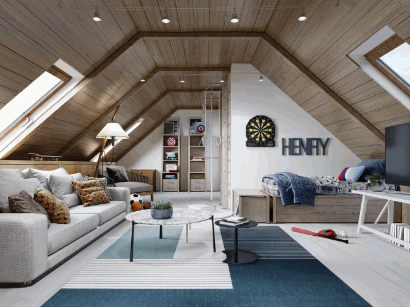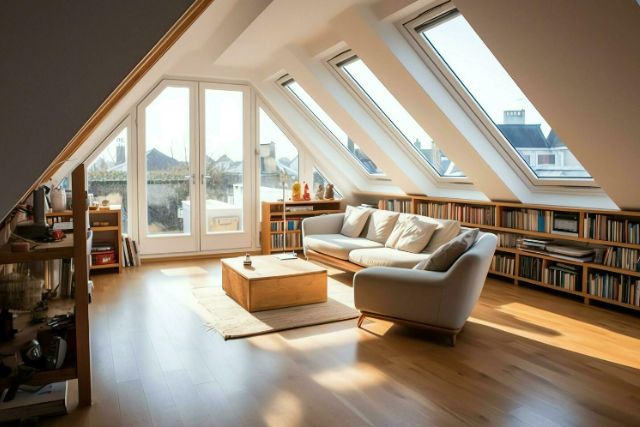Thinking of transforming your loft into a cosy living space? A loft conversion is a fantastic way to maximise your home’s potential, but getting modular furniture into that newly converted area can be a challenge.
From narrow staircases to limited access points, moving items into a loft requires careful planning and creativity. This guide covers the benefits of adding furniture to your loft conversion, the challenges you might face, and effective techniques to ensure a smooth transition.
Get ready for helpful tips and safety precautions that will make your loft conversion a stylish and functional cosy retreat!
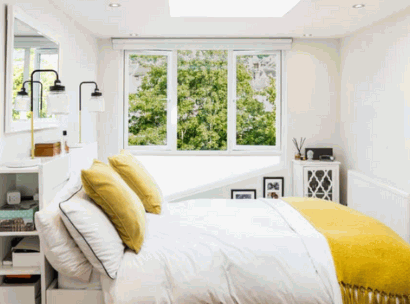
What Is A Loft Conversion?
A loft conversion is a transformative architectural design process that involves converting an unused loft space into a functional area, often enhancing the overall home aesthetics and utility of a home.
This process can create a variety of rooms, such as a snug retreat, kids rooms, or home office, tailored to meet the needs of the inhabitants.
By employing stylish solutions and incorporating practical built-in furniture, homeowners can maximise space utilisation while adhering to building regulations, resulting in a clutter-free living environment that blends seamlessly with existing home decor and enhances the overall interior design.
Check out: How To Insulate My Loft Conversion
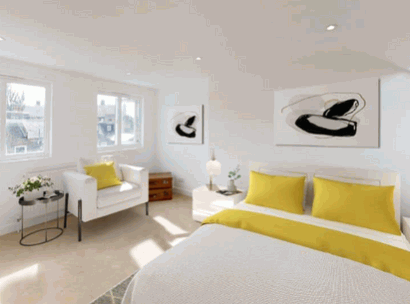
Why Would Someone Want To Get Furniture Into A Loft Conversion?
Getting furniture into a loft conversion serves multiple purposes, primarily to create a practical place that enhances functionality while maximising space in small spaces. With the right selection of modular sofas, transforming tables, and fitted wardrobes, homeowners can craft a stylish seating area that complements their loft design, whether it features a modern theme or a Victorian theme.
Moreover, incorporating upcycled furniture and space-saving stairs can optimise storage efficiency, providing a cohesive look that aligns with the overall interior design aesthetic while enhancing the functional designs of the space.
Maximising Space
Maximising space in a loft conversion is essential for creating a functional and comfortable living area, particularly in small spaces where every inch counts. By leveraging innovative design strategies, homeowners can greatly enhance the efficiency and appeal of their lofts, turning them into inviting environments that cater to a variety of lifestyles.
One effective approach is to consider multifunctional furniture, such as coffee tables that double as storage units or folding-wall beds with hidden compartments. This not only declutters the space but also adds to the overall home decor aesthetic.
- Open shelving can be a game-changer, allowing both decorative displays and practical storage without the bulkiness of traditional cabinetry.
- Positioning furniture along the walls can free up central floor space and create a more expansive feel.
- Incorporating mirrors strategically will reflect light and give the illusion of depth, enhancing the overall interior aesthetics.
Choosing a lighter colour palette can also make the loft appear more airy and spacious, enhancing the comfort and functionality of this unique living area.
Adding Functionality To The Space
Adding functionality to loft conversions is crucial for ensuring that these spaces meet the diverse needs of their users, transforming them into practical places that enhance daily living and serve as cosy retreats.
Homeowners can maximise their loft's potential by adopting flexible design principles that allow for seamless transitions between various uses throughout the day, ensuring a practical place for both relaxation and work. For instance, using a sofa bed can provide comfortable seating for visitors while maintaining the room's primary function as a living space.
Additionally,
- folding desks
- versatile shelving units
- storage ottomans
can reduce clutter, enhancing both utility and aesthetic appeal with storage solutions. Design strategies like creating designated zones can further ensure that each section of the loft serves multiple purposes without compromising style, maximising both functionality and comfort.
With the right approach, a loft conversion can truly become a sanctuary that caters to both work and relaxation, making it a valuable addition to any home.
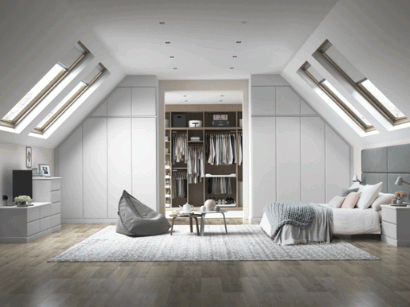
What Are The Challenges of Getting Furniture Into A Loft Conversion?
Getting furniture into a loft conversion presents several challenges that can hinder effective space utilisation and overall design aesthetics, particularly due to limited access points and narrow staircases that can restrict furniture layout and movement. These obstacles can make transporting larger items problematic, while awkward angles in the loft room may restrict furniture placement options.
Therefore, understanding these potential hindrances is crucial for devising effective strategies for managing space-saving solutions and ensuring storage efficiency throughout the conversion process, resulting in a better furniture layout.
Limited Access Points
Limited access points often pose a significant challenge for moving furniture into a loft conversion, complicating the overall furniture layout and space utilisation while limiting options for unique furniture arrangements. These restrictions might necessitate careful planning and consideration when choosing the types of furniture to include, as well as how to arrange them effectively within the loft room for optimal space utilization. Narrow pathways or small doorways can limit the size and dimensions of furniture pieces, necessitating the selection of space-saving options and unique furniture that accommodate these constraints.
Understanding how limited access points impact furniture placement can greatly enhance your loft's functionality and overall design. To navigate these obstacles, it’s essential to think creatively about your furniture choices, considering both practicality and aesthetics. Consider opting for modular sofas and multi-functional tables that can easily be disassembled or adjusted to fit through tight spaces, providing practical solutions for your loft conversion.
- Look for foldable chairs and nesting tables that can be tucked away when not in use, maximising space and maintaining a clutter-free environment.
- Wall-mounted shelves can free up valuable floor space while providing essential storage.
By selecting the right pieces and employing strategic placement, you can transform the unique challenges of your loft into opportunities for innovative design and efficient space use, ensuring a successful loft conversion.
Narrow Staircases
Narrow staircases are another common obstacle when trying to transport furniture into a loft conversion, limiting the type and size of items that can be easily manoeuvred through space-saving stairs. To ensure successful furniture transport, it is essential to consider modular furniture options and designs that can be easily disassembled or reconfigured. This approach not only facilitates entry into the loft but also enables a more efficient use of space while ensuring a stylish and functional loft room.
When faced with such spatial limitations, one might benefit from evaluating the following strategies for effective furniture layout:
- Measure everything: Before purchasing any item, measure both the furniture and the staircase to identify feasible dimensions, ensuring a seamless fit for the loft conversion.
- Choose lightweight materials: Opt for furniture made from lighter materials, making it easier to navigate through tight spaces.
- Consider alternative transport methods: Hiring professionals who specialise in navigating narrow spaces can save time and reduce the risk of damage.
By keeping these elements in mind, individuals can not only overcome the challenges posed by narrow staircases but also curate a loft space that is both functional and aesthetically pleasing, enhancing the overall home decor.
Awkward Angles And Corners
Awkward angles and corners in a loft conversion can complicate furniture layout decisions and hinder effective space utilisation, affecting overall interior design.
It's essential to understand how these peculiarities shape the overall design of the room and impact functionality.
Homeowners faced with such challenges should consider a few strategies to transform these problematic areas into stylish and functional elements, enhancing the living experience.
- Employing built-in furniture can optimise space, allowing for seamless incorporation into the structure while maintaining the overall architectural design.
- Utilising modular or multi-functional items enables flexibility, making changing room layouts a doddle and enhancing storage solutions.
- Incorporating floating shelves or corner bookcases can enhance vertical storage, keeping the floor area open and uncluttered while enhancing home aesthetics.
By thoughtfully addressing these design aspects, one ensures that awkward spaces become an integral part of the overall aesthetic, harmonising form and function while enhancing the living experience through clever design.
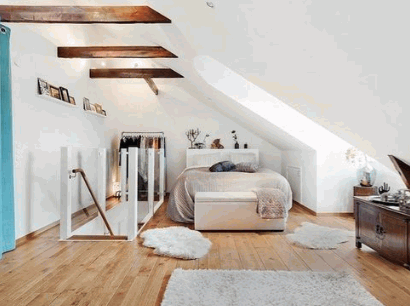
How To Prepare For Getting Furniture Into A Loft Conversion?
Preparing to get furniture into a loft conversion requires meticulous planning and execution, beginning with measuring both the furniture and the available space to ensure a seamless fit within the loft room. This proactive approach not only helps avoid potential issues but also enhances overall space utilisation, resulting in an efficient and aesthetically pleasing interior design suitable for cosy living.
Clearing the pathway is an essential step to facilitate easier transport, while disassembling larger pieces can further aid in navigating tight spots and ensuring a successful move for your loft conversion.
Measure The Furniture And The Space
Measuring the furniture and the available space is a critical first step in the preparation process, as it ensures that the selected pieces will fit appropriately within the loft conversion, maximising storage efficiency and design appeal. This careful assessment helps optimise space utilisation and allows homeowners to plan a furniture layout that enhances both functionality and aesthetics, ensuring a stylish and inviting loft room.
By taking accurate measurements, one can avoid the frustration of arriving at the loft only to find that key items cannot be accommodated.
When embarking on this measuring endeavour, it's essential to gather a tape measure, a notepad, and ideally a friend to assist. Start by measuring the dimensions of each furniture item including length, width, and height. For the space itself, consider the overall dimensions of the room, making note of any architectural features such as sloped ceilings or built-in shelving that can influence placement.
- Begin from the corners of the room to ensure all sides are accounted for.
- Measure other necessary areas like doorways and pathways to confirm smooth entry and exit.
- Always record your measurements while double-checking them for accuracy.
In this way, one can create a layout that not only accommodates the furniture comfortably but also maintains the open, airy feel that loft conversions are known for.
Disassemble Furniture If Possible
Disassembling furniture, when feasible, can significantly ease the transport process, facilitating entry into loft conversions through narrow access points and staircases. This space-saving technique not only makes carrying bulky pieces more manageable but also minimises the risk of damaging walls or furniture during transport. By considering modular furniture or items designed for easy disassembly, homeowners can further streamline the logistics of moving their belongings into the loft room.
Taking the time to dismantle certain pieces can prevent costly repairs and help avoid the frustration of manoeuvring large items through tight spaces. Disassembling furniture can also lead to more organised packing, allowing for better use of available space in moving vehicles. For example, a bed frame can typically be broken down into smaller components like the headboard, footboard, and slats, making it simpler to transport. Similarly, tables with removable legs or shelves from cabinets can also help ease the lifting and shifting process.
- Consider removing items from inside cabinets or dressers prior to disassembly.
- Utilise labelled bags or containers for screws and small parts to avoid misplacement.
- Be mindful of the assembly instructions, as they will assist in reassembling pieces in the new space.
By employing these practical tactics, one can maximise efficiency and ensure that furniture arrives in pristine condition.
Clear The Pathway
Clearing the pathway leading to the loft conversion is a vital preparatory step that facilitates efficient furniture transport, ensuring that obstacles do not hinder the process. This step enhances not only the physical movement of items but also the overall storage solutions available in the loft room, allowing for a smooth transition from one area to another. By maintaining a clutter-free route, homeowners can focus on arranging their space more thoughtfully after the move.
To achieve this, it’s essential to evaluate the entire route by:
- Identifying and removing any furniture or decorative items that may obstruct the pathway.
- Ensuring that any loose wires or cables are secured or removed to prevent tripping hazards.
- Using temporary storage solutions, such as boxes or bins, to organise items that reside in the pathway.
By implementing these practical tips, not only does it enhance safety during the move, but it also boosts the efficiency of the entire furniture transport process. Ultimately, a clear pathway showcases the potential of the loft conversion and allows homeowners to maximise their available space.
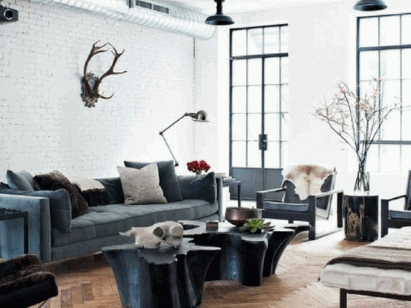
What Are The Techniques For Getting Furniture Into A Loft Conversion?
In terms of moving furniture into a loft conversion, several effective techniques can facilitate the process, ensuring that items arrive safely and efficiently while maximising space.
Hoisting furniture through a window is a practical solution for larger items, while furniture lifts provide an even more streamlined approach, particularly for heavier pieces.
Alternatively, carrying furniture up narrow staircases requires careful planning and the use of space-saving designs to minimise risk and enhance functionality.
Hoisting Furniture Through A Window
Hoisting furniture through a window is an effective method for transporting larger pieces into loft conversions, particularly when access points are limited. This technique minimises the challenges posed by narrow staircases and tight corners, offering an efficient solution for ensuring that bulky items reach their destination safely. Careful planning and assistance are essential to ensure both safety and successful execution during the hoisting process.
When considering sending large furniture through a window, it’s vital to take several logistics into account. First, determine the weight and dimensions of the item, as understanding its size can dictate the method you employ. Verbal communication with all parties involved is crucial to coordinate the hoisting process effectively.
- Safety Precautions: Always wear protective gear, including gloves and hard hats, to guard against accidents.
- Necessary Tools: Essential tools for the task may include a sturdy rope, a lifting strap, and pulleys to help manoeuvre the furniture smoothly.
Ensure that the area surrounding the window is clear of obstacles and check for any potential hazards such as electrical wiring or overhanging branches. By adhering to these considerations, the entire process will be both safe and efficient—making hoisting furniture through a window a viable solution for tricky situations.
Using A Furniture Lift
Using a furniture lift is a highly efficient method for transporting heavy or bulky items into a loft conversion, streamlining the process while minimising physical strain on those involved. Furniture lifts can navigate tight spaces and narrow access points with ease, ensuring that items are safely transported without damage to both the furniture and the surrounding environment. This approach not only enhances space-saving capabilities but also allows for a more organised and effective layout within the loft room.
Along with their practical benefits, furniture lifts offer numerous advantages that can significantly improve the logistics of moving and positioning large objects.
- Accessibility: They are designed to maneuver through cramped hallways and staircases, where traditional moving methods may falter.
- Weight Capacity: Most lifts can handle significant weights, often accommodating loads of up to 500 kg or more, making them suitable for various items from settees to large appliances.
- Versatility: Different types are available, including platform lifts, hoists, and service lifts tailored for specific requirements.
With these features, using a furniture lift transforms the daunting task of moving into a manageable and efficient experience.
Carrying Furniture Up The Stairs
Carrying furniture up narrow staircases remains a common technique for getting items into loft conversions, requiring careful planning and teamwork to ensure safety and efficiency. This method is particularly effective for smaller, more manageable pieces that can navigate tight turns and angles, making it essential for optimising space utilisation within the loft room. Employing space-saving designs and modular furniture can facilitate a smoother carrying process, enhancing the overall functionality of the space.
To maximise effectiveness, it is vital to establish clear communication among team members before attempting the lift. Here are some strategies:
- Assess the Path: Before moving, take time to evaluate the staircase and the dimensions of both the furniture and the available space. This will prevent any awkward moments or potential injuries.
- Divide and Conquer: Assign specific roles to each individual, such as the lead who guides the direction and others who support by lifting and balancing the load.
- Use Proper Techniques: Lift with the legs, not the back, and maintain a stable grip on the furniture to reduce the risk of accidents.
Implementing these strategies can significantly reduce stress and enhance safety, making the entire process more manageable and enjoyable.
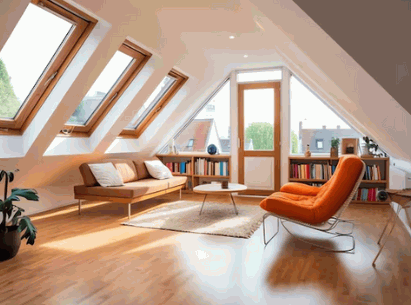
What Are The Safety Precautions To Consider?
Ensuring safety during the process of moving furniture into a loft conversion is paramount, requiring attentiveness to various precautions to prevent accidents and damage. Wearing proper protective gear, such as gloves and sturdy footwear, helps safeguard individuals during transport.
Additionally, securing furniture during the move is essential to ensure that items remain stable and intact throughout the journey, minimising risks associated with navigating limited access points and narrow staircases.
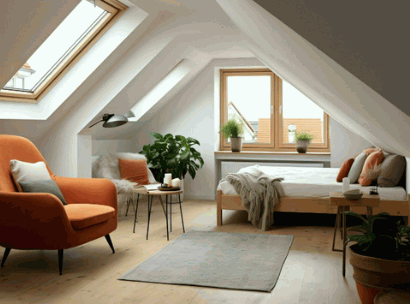
Wear Proper Protective Gear
Wearing proper protective gear is a fundamental safety precaution that should always be prioritized when transporting furniture into a loft conversion.
In fact, the importance of this gear cannot be overstated, as it plays a vital role in safeguarding against physical strain and potential accidents. Key elements to consider include:
- Gloves: These protect the hands from cuts, abrasions, and slippage, ensuring a secure grip on heavy items.
- Back support: A supportive belt can aid in stabilising the back muscles, reducing the risk of strains when lifting.
- Durable footwear: Sturdy shoes with proper grip help in preventing slips and falls, which can be particularly hazardous on stairs or uneven surfaces.
By equipping everyone involved with these essential items, the risk of injury is significantly diminished. This collective awareness allows for a more focused and effective transport process, promoting safety while navigating tight spaces.

Have Enough People To Help
Having enough people to help is crucial for ensuring safety and efficiency when transporting furniture into a loft conversion, as teamwork significantly reduces the risk of accidents. Coordinating efforts among multiple individuals ensures that heavier items can be moved with ease, minimising strain and enhancing overall transport safety. By dividing responsibilities and utilising teamwork, the process becomes more streamlined, allowing for a smoother relocation of furniture into the loft room.
When organising a moving effort, it’s vital to consider these key strategies:
- Prepare in Advance: Create a checklist of all items to be moved and designate specific roles for each team member.
- Use Proper Techniques: Teach proper lifting techniques to avoid injuries and ensure efficiency during the move.
- Communicate Clearly: Keep the lines of communication open among team members to coordinate efforts effectively.
- Utilise Tools: Make use of moving equipment like trolleys and straps to ease the burden of heavy items.
By following these tips, individuals can ensure that their furniture transport is not only successful but also safe, creating a more enjoyable experience for everyone involved.
Secure Furniture During Transport
Securing furniture during transport is a vital safety precaution that helps protect both the items being moved and the individuals involved in the process. Using straps, blankets, or specialised furniture moving equipment ensures that items remain stable throughout the journey, preventing damage caused by shifting or tipping during manoeuvres through limited access points. This precaution not only enhances transport safety but also contributes to the effective use of space within the loft room once the furniture is in place.
There are several effective methods to ensure that furniture is secured properly during the moving process:
- Using Straps: Using heavy-duty straps can secure larger items tightly to the moving vehicle, minimising movement.
- Blanket Protection: Employing moving blankets protects surfaces from scratches and dents.
- Specialised Equipment: Investing in dollies and sliders can assist in manoeuvring bulky pieces, easing strain on the mover and reducing the risk of accidents.
Establishing these practices significantly mitigates potential hazards and contributes to a more efficient moving experience. Ultimately, it is essential that the right precautions are taken to safeguard both belongings and personnel, ensuring a smooth transition into the new space.
